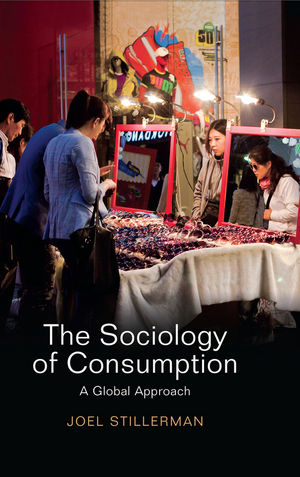The Sociology of Consumption: A Global Approach, authored by Joel Stillerman, offers a long-overdue account of the processes and cultural relevance of consumption in the twenty-first century. Patricia Hogwood finds much to admire in this solid introduction to the diverse theoretical literatures on consumption and its exploration of the new opportunities and challenges arising for governments and citizens alike due to rapid changes in contemporary practices of consumption.
The Sociology of Consumption: A Global Approach. Joel Stillerman. Polity. 2015.
 In The Sociology of Consumption: A Global Approach, Joel Stillerman deploys relational, material culture and status-based analyses of consumption in the twenty-first century to elaborate and evaluate three themes: differential consumption in the Global North and South; consumption and inequality; and consumer citizenship. A key conclusion is that while consumer practices aimed at satisfying objective and subjective needs are universal, the definition of such practices is context-specific, dependent on host cultures, communities and cohorts.
In The Sociology of Consumption: A Global Approach, Joel Stillerman deploys relational, material culture and status-based analyses of consumption in the twenty-first century to elaborate and evaluate three themes: differential consumption in the Global North and South; consumption and inequality; and consumer citizenship. A key conclusion is that while consumer practices aimed at satisfying objective and subjective needs are universal, the definition of such practices is context-specific, dependent on host cultures, communities and cohorts.
Throughout the book, Stillerman makes every effort to integrate the theoretical, analytical and empirical strands of his narrative. Chapter Two offers a succinct summary of the historical development of marketing and retail from the commercial and industrial revolutions to the post-war era of mass consumption. Into this history he incorporates insights into the way in which participation in market exchange was transformed from the level of repeated functional and status-confirming processes into a self-aware, context-specific consumer identity; the recognition, in advertising, of the emotional satisfaction that may derive from the acquisition and use of goods; the potential for defusing political conflict through supplying compensatory consumer goods to unhappy workers; and the organisational capacity of consumer practices that now appear to supplement, or even supplant, the traditional lines of social stratification through work and employment.
Chapter Three, tracing the breathtaking innovations in retail, marketing and technology of the late-twentieth and early-twenty-first century, is seeded with leading debates on consumer individualisation versus new ‘tribal’ consumer communities. There can be no doubt that the increasing diversity and accessibility of goods is producing a more reflexive form of consumerism, permitting (or arguably requiring) individuals to exhibit increasingly personalised consumption tastes in order to fulfil their identity and status needs. New communications technologies in particular have promoted the increasing isolation of the acquisition and consumption of goods, such as online shopping or downloading music. Most theorists allow that new forms of consumer communities are emerging to structure such ‘individualist’ practices; Stillerman offers an excellent summary of the most influential attempts to define and analyse these.
 Image Credit: Shop window, Switzerland (Christoph Michels)
Image Credit: Shop window, Switzerland (Christoph Michels)
Chapter Four offers the best introduction I have yet seen to the classic and contemporary sociological literature on consumption, status and class. The themes introduced here – particularly that of inequalities of consumption – are further finessed in Chapter Five through an intersectional perspective, with discussions centring on ambivalence and objectification. Ethnic minorities, for instance, experience discriminatory access to retail and credit markets and yet their style innovations may be adopted and consumed by the white mainstream; women, meanwhile, have a dual role as agents and objects of consumption. Chapter Six follows a further axis of difference: the stages in a consumer’s life from childhood to old age. It asserts that individuals’ place in the life course and the specific cultural attitudes embedded in their age cohort help to establish additional reference points in the development and maintenance of their consumer identities.
Stillerman devotes Chapters Seven and Eight to the theme of consumer citizenship, exploring expressions of consumer activism (where consumer choices are made consciously as a tool of political expression or resistance) and consumer nationalism (where governments recruit citizen support, through their consumption practices, to uphold government policy aims). As examples of consumer activism, Stillerman cites the emergence of producer and consumer cooperatives seeking to alleviate the impacts of exploitation on the working poor by employers and retailers following industrialisation. Here he takes up his argument on the context-specific construction of consumer practices. He notes the differences in cooperative movements in other parts of the world, each explained by the specific needs of their members. Government attempts to co-opt citizen consumers to support policy ends have typically included urging self-restraint in consumption to support a war effort or encouraging free spending to boost the economy. Stillerman then turns to the impacts of globalisation and the information revolution on consumer citizenship, including new political platforms for ethical consumption, the selective opting-out of consumer society and global consumer activism.
In a work of this scope, something has to give. Inevitably, coverage is patchy in places. In particular, the book does not entirely fulfil its promise of a global approach. Empirical examples are taken mostly from the Global North (mainly the USA, France, the UK and Canada), supplemented by some valuable and less well-known work on countries of the Global South, including Trinidad, as well as Stillerman’s own body of work on Chile. However, there is nothing on consumption in post-socialist societies: a rich field for understanding consumer (re)socialisation, aspirations, behaviours and citizenship in a transitional political and economic landscape. Also, whereas the leading scholarly positions on various concepts of consumer ‘cultures’ and the relationships between consumption and class are expertly summarised and presented, there is no equivalent treatment of class concepts per se. The theoretical underpinnings of the chapters on consumer citizenship are less substantial than those on the themes of inequality. A major omission here is a consideration of cosmopolitanism and citizenship.
Finally, a further cost of the book’s ambitious scope is space to reflect at greater length on some of the intriguing developments to which Stillerman alludes. I would have liked to have seen more of his own evaluation of issues such as the defining features of our retail world. Stillerman points out that this is no ‘natural’ phenomenon (21), but he could go further by exploring the eccentricity and dysfunctionality of these structures. Our close association of property and trade with democracy is one example: the principle of private ownership in the western liberal tradition and the overriding priority accorded to the profit principle under neoliberalism that throughout the Global North has fed constructs of social respectability, citizenship and social conflict. Likewise, more would be welcome on the apparently simultaneous individualisation of consumer identities alongside the collective and creative consumer strategies practised both by consumers in the Global South and Zygmunt Bauman’s (2007) new poor of ‘flawed consumers’: namely, those at the margins of western society who suffer the greatest collateral damage from the prioritisation of consumerist activity as a marker of social success.
Overall, Stillerman’s timely work will serve as a comprehensive and thought-provoking set text for advanced undergraduate and postgraduate students. It is also a wonderful entry point for any reader who has ever pondered the consumer feeding frenzy in the run-up to Christmas on London’s Oxford Street, the proliferation of pay-day loan shops on the high street or the irony creeping into television adverts.
Patricia Hogwood is Reader is European Politics at the University of Westminster. She has published on UK devolution and EU policymaking in a comparative context. Her other research interests include EU immigration policy and the externalisation of internal security and the impacts of German unification on German identity, democracy and public policy. Read more reviews by Patricia Hogwood.
Note: This review gives the views of the author, and not the position of the LSE Review of Books blog, or of the London School of Economics.







